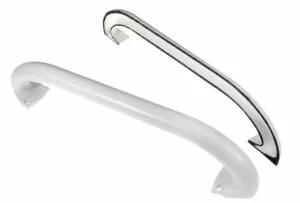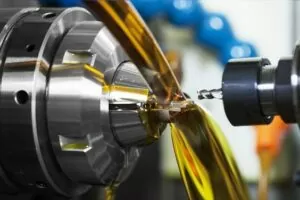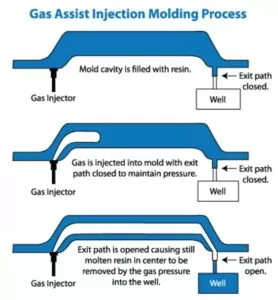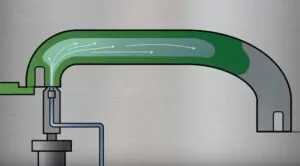Introduction
Gas assist injection molding (GAIM) is a manufacturing process that utilizes pressurized gas as an additive to injection molding plastic materials. This involves injecting molten resin into a mold cavity before injecting pressurized gas (usually nitrogen gas) to displace it and form a hollow core in the part, significantly reducing material requirements while maintaining the structural integrity of its final form.
Gas assist injection molding stands out in its ability to use less material while still meeting strength and functionality requirements for its parts, leading to significant cost reductions due to less plastic material used, reduced power usage, and shorter molding cycles. Furthermore, this technique offers enhanced surface definition, better dimensional stability, reduced sink marks, and produces high-quality finished products resulting in substantial cost savings and cost reductions.

II. How does gas assist injection molding work?
Gas-assist plastic injection molding works by injecting molten plastic resin into a mold cavity, followed by the injection of pressurized gas, typically nitrogen gas. The pressurized gas flows through gas channels in the mold cavity, which inflates and displaces the molten plastic material, creating a resultant hollow core within the molded part.

Compared to conventional injection molding, which relies solely on the injection of molten plastic into a mold cavity, gas-assist plastic injection molding offers several advantages. The use of pressurized gas in gas-assist plastic injection molding allows for the creation of hollow cores in molded parts, reducing material usage while maintaining structural integrity. This results in substantial cost savings and reduced power consumption, as well as shorter molding time cycles. Gas-assisted injection molding also offers enhanced surface definition, improved dimensional stability, and reduced sink marks, resulting in high-quality finished products. Overall, gas-assisted injection molding offers a more efficient and cost-effective alternative to conventional injection molding.
III. Advantages of gas assist injection molding
Gas assisted molding offers several advantages over conventional injection molding. Here are some of the key benefits:
Reduced material usage:
Gas assisted molding allows for the creation of hollow cores in molded parts, which reduces the amount of plastic material required while maintaining the structural integrity of the part. This results in substantial cost savings and reduced power consumption.
Enhanced surface definition:
Gas assist molding offers enhanced surface definition, resulting in high-quality finished products with smooth and detailed surfaces. This is particularly important in applications where appearance and texture are important, such as automotive and consumer goods.

Dimensional stability:
Gas assist injection molding offers improved dimensional stability, resulting in consistent and accurate part dimensions. This is particularly important in applications where precise tolerances are required, such as medical devices and aerospace components.
Reduced sink marks:
Gas assist injection molding reduces sink marks, which are common defects in conventional injection molding caused by uneven cooling of the part. This results in a smoother surface finish and improved appearance of the part.
Reduced wall thicknesses:
Gas assist injection molding allows for the creation of parts with reduced wall thicknesses, resulting in lighter and more cost-effective parts. This is particularly important in applications where weight reduction is a critical factor, such as automotive and aerospace components.
Component shape flexibility:
Gas assist injection molding offers greater component shape flexibility, allowing for the creation of complex shapes and designs that may be difficult or impossible to achieve with conventional injection molding.
Smooth surface finishes:
Gas assist injection molding offers a smooth surface finish, resulting in a high-quality appearance for the molded part. This is particularly important in applications where aesthetics are important, such as consumer goods and electronic devices.
IV.Gas injection methods
There are two primary gas injection methods used in gas assist injection molding: the internal gas injection process and the external gas injection process.
- Internal gas injection process:In the internal gas injection process, pressurized gas (usually nitrogen gas) is injected directly into the center of the molten plastic stream as it enters the mold cavity. The gas then flows through the molten plastic, creating a hollow core within the molded part. This method is used for creating long, narrow hollows in parts, such as tubing or handles.
- External gas injection process:In the external gas injection process, pressurized gas is injected into the mold cavity through one or more gas channels in the mold. The gas then flows around the edges of the molten plastic, pushing it into the center of the mold cavity and creating a hollow core within the part. This method is used for creating hollow cores in more complex parts, such as automotive components or consumer goods.

Both gas pressure methods offer benefits in terms of reducing material usage, improving dimensional stability, and reducing sink marks. The choice of gas injection method will depend on the specific requirements of the part being molded and the desired outcome.
V. Materials used in gas assist injection molding
Gas assist injection molding uses similar materials as conventional injection molding, including plastic resins such as polypropylene, polycarbonate, and ABS.
Gas assist injection molding utilizes glass-filled grades of plastic resins in addition to standard resins for applications requiring greater durability and wear resistance, such as gas assist injection molding. Glass fibers added into these resins increase strength and stiffness – perfect for applications where durability is crucial.
Glass-filled plastic resins are frequently utilized in automotive, aerospace, and industrial sectors where high-strength/performance components are necessary. Furthermore, these resins can also be found in household appliances like power tools, vacuum cleaners, and electronic devices for the production of consumer goods such as power tools/vacuum cleaners/electronic devices.

Plastic resin selection will depend on the requirements for molding the part in question, such as its intended use, strength, and durability requirements. Manufacturers may also factor in factors like cost, availability, and processing characteristics when making their decision about gas-assisted injection molding resin selection.
VI.Gas assist injection molding applications
Gas assisted injection molding has many uses across multiple industries due to its many advantages. Here are a few industries that utilize it:
Automobile Industry:
Gas assisted injection molding has long been used to produce automotive components such as interior trim panels, door handles, and instrument panel bezels. Benefits for this industry include reduced material usage, enhanced dimensional stability, and greater surface definition.
Aerospace industry:
Gas assist injection molding can be used to produce various aerospace components, including interior cabin components and cockpit instrument panels. Benefits in this field include reduced material usage, enhanced dimensional stability, and decreased weight of final products.
Consumer Goods Industry:
Gas-assist injection molding can be used to produce an array of consumer goods such as power tools, household appliances, and electronic devices. Benefits for this industry include enhanced surface definition, improved dimensional stability, and decreased sink marks.

Medical Industry:
Gas assisted injection molding technology is used extensively within this sector for creating components like instrument handles, housings, and connectors for medical equipment. Benefits in this sector include improved dimensional stability, reduced sink marks, and enhanced surface definition.
Gas assist injection molding provides various benefits that improve final products while simultaneously cutting costs in each of these industries, including decreased material usage, enhanced surface definition, dimensional stability improvements, sink mark reductions, and weight reductions, as well as shape flexibility of components produced through gas assisted injection molding. By taking advantage of its many benefits for manufacturing businesses in these industries, manufacturers can produce high-quality items at cost-effective and efficient levels.
Conclusion
Gas-assist injection molding is an innovative manufacturing technique with many advantages over traditional injection molding, including reduced material usage, enhanced surface definition, better dimensional stability, reduced sink marks, weight savings, and component shape flexibility.
Gas-assist injection molding may present some drawbacks for manufacturers, including high initial equipment costs and limited design choices. Manufacturers considering using this process should carefully evaluate all relevant factors to ascertain whether this approach best meets their requirements.
Overall, gas-assist injection molding is an efficient manufacturing process that offers significant cost savings and improved product quality. It is widely utilized across several industries – automotive, aerospace, consumer goods, and medical among them – providing manufacturers with an opportunity to produce high-quality products while cutting material usage and costs significantly.






